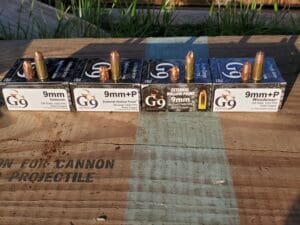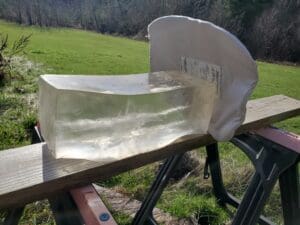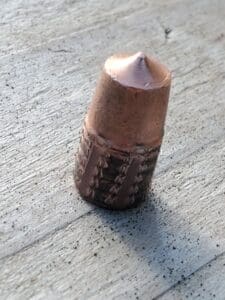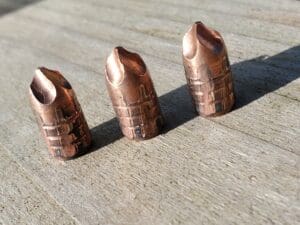Ammunition can be a tricky beast. We love it, but hate paying for it. We want the best in new technology, but only once it’s as proven as the old stuff. After all that we want the best there is, at a low price. I don’t envy any ammunition manufacturer looking to dethrone the top few, but I applaud all who try. With that, let’s look at G9 Defense.
G9 Defense was founded in 2013. The name G9 is derived from the ballistic coefficient scales used to determine ballistic trajectoryt.
G9 was interested in having some testing done on four of their Defense’s 9mm loads, the 124-gr. +P Woodsman, the 80-gr. External Hollow Point (EHP), the 80-gr. External HP +P, and the 126-gr. Subsonic round. This represents all of their 9mm offerings, minus the 115-gr. FMJ round. I’m testing them with both a Glock 43X and a Zenith ZF-5P (Mp5K clone). Velocities were recorded with a Caldwell chronograph, and some terminal ballistics data were captured with Clear Ballistics calibrated gelatin.

Let’s cover a brief overview of each round before we get to testing.
G9 Defense 9mm
124-gr. +P Woodsman: Advertised muzzle velocity (MV), 1200fps. Solid copper projectile, designed with hunting in mind. The projectile is reminiscent of a semi-wadcutter, save for the sharp point. The projectile is a solid copper design, eliminating the chance of jacket seperation. Designed for penetration through hide and bone, G9 Defense advises against carrying the Woodsman for EDC due to its extreme penetration.
80-gr. External Hollow Point: Designed as a barrier blind round, the EHP is intended to maintain its shape through many surfaces and still dump energy into soft tissue. The “phillips head screwdriver” shape is effective at preventing the “clogging” effect that stops many hollow point rounds from expanding, as well as boring a significant permanent wound cavity.
80-gr. EHP +P: Same bullet, but loaded to higher pressure for faster velocity. This should lead to deeper penetration, a bigger wound channel and slightly flatter trajectory. All EHP rounds are solid copper designs.
126-gr. EHP Subsonic: The head of the projectile is the same, but the body of the projectile is longer giving it more mass. Subsonic rounds are designed to be used with a suppressor, the lack of a supersonic boom being one major component in noise reduction.
Inspection and Velocity Testing
First off, I give all the rounds a once over. I like the design of the EHP. It’s nice to see modern engineering and machining producing something new and hopefully more effective. All four types of ammo were clean and had consistent seating depth. Seems like a given, but I’ve seen some crazy stuff pass QC from other brands before.
I shot each ammunition type through both the Zenith Mp5k clone (Mp5k hereafter) and the Glock 43x (G43x). Here are the average chronographed velocities.
- 124-gr. Woodsman +P: 1160fps (mp5k), 1088fps (G43x)
- 80-gr. EHP: 1602 fps (Mp5k), 1435 fps (G43X)
- 80-gr. EHP +P: 1662 fps (Mp5k), 1489 fps (G43X)
- 126-gr. EHP Subsonic: 1011fps (Mp5K), 935fps (G43x)
Notes:
The 126-gr. Subsonic round was really quiet through the Mp5k with an AAC TiRant 45 suppressor. Noticeably more so than other 9mm rounds traveling around the same speed, from the same gun/can combo. Whether this is due to the type of powder used or the projectile shape, I don’t know. But I like it!
The +P loading of the 80-gr. EHP produced a little more velocity, but the difference in recoil was barely noticeable.
Look at the 80-gr. rounds, you’ll notice there’s not a tremendous length on the bullet with rifling marks. The lower surface area contacting the barrel reduces friction, increasing velocity. Cool design, as long as it shoots accurately.
Gel Block Testing

I ran four to five rounds of each of the four 9mm loads G9 Defense sent me through my ballistic gel block. This is calibrated 10% gelatin from Clear Ballistics.
- 124-gr. Woodsman +P: All rounds penetrated the 14-inch long brick. I caught them in a Level IIIa ballistic panel on the backside. No deformation. I could reload these if not for the rifling marks.

- 80-gr. EHP: Rounds stopped between 13 inches and 14 inches. A couple were sticking out the backside of the gel but didn’t leave the block. Zero deformation.

- 80-gr. EHP +P: All of the rounds exited the gel block with 14 inches plus of penetration.

- 126-gr. EHP Subsonic: Like the 80-gr. EHP, all rounds stopped between 13 inches and 13.99 inches. The deepest round was about the thickness of a sheet of paper from the end of the block.

Notes:
None of the rounds showed significant deformation. This is a testament to the strength of all-copper construction. The wound channels left behind in the gelatin were significant for each round, showing violent turbulence until between 8 inches and 11 inches deep, with the two +P rounds showing the most violent cavities, as expected.
Just for kicks, I shot the 80-gr. +P round through the Mp5k at the Level IIIa panel, and it zipped through easily. Granted, the panel is out of date, but it was interesting to see.
Accuracy Testing
After parsing out multiple studies regarding the average distance in a defensive shooting, most available sources roughly agree that 5 to 7 yards is nearing the maximum likely distance one might encounter. Clearly, sub-MOA precision isn’t a necessity.
That being said, we still need accurate shots. Rather than test from a rest while shooting paper, I prefer real-world shooting. I test at 5 and 15 yards. At 5 yards, I shoot up one of those “self-healing” cubes, brand name long since forgotten. At 15 yards, I have a 4-inch wide, 21-inch tall strip of steel on a spring-loaded stand. It’s generally torso shaped, but significantly smaller, more accurately representing the vital zone.
The Mp5k gave pretty predictable results, owing to more precise sights and a longer sight radius, as well as being more stable than a handgun. Making the cube dance was child’s play, and I easily kept all the rounds where I wanted on the steel target. I’m not going to pretend this would be difficult for nearly anyone, just showing that all four types of G9 Defense ammo did exactly what they should.
The 80-gr. +P definitely hit the steel with more authority than the rest. Speed kills!
Going to the Glock 43x was predictably more challenging, but the G9 Defense ammo really did its part. Once I realized the rounds have a point of impact a bit to the left of where my irons are zeroed for my usual EDC round, I had the orange cube target rolling all over the field. Switching to the steel target met with a similar result, once I held right a ways I was able to keep slow fire centered in the steel, and faster strings of fire were all on target. Except for a couple I’ll admit to pulling…practice is always important.
The Glock 43x especially agreed with the 124-gr. +P Woodsman. The recoil impulse was mildly snappy, and the slide returned back to the point of aim pretty predictably. It was just one of those times when the gun, shooter and ammo all match up perfectly.
The Truth As I Know It, So Far
I’ve been sitting on these G9 Defense rounds for a while, waiting for a specific gun to come in. It came to the point I needed to get some shooting done before the snowstorm hit here. I do have more testing planned for when spring hits a little harder, including material penetration testing using drywall, plywood and more. Consider this a review in progress, to be updated later with more test results.
Ratings (out of five stars):
Accuracy: * * * *
Each of the G9 Defense loads delivered very good accuracy. Well past “acceptable” and deep into “Very Good” territory. The 126-gr. subsonic was exceedingly consistent.
Handling: * * * * *
Recoil was moderate for each load, with the 80-gr. +P and 124-gr. +P rounds surprising me by not increasing recoil by much at all.
Reliability: * * * * *
The hundreds of rounds I fired, of all four loads, through both guns, were 100% reliable. Five hundred rounds isn’t a massive sample size, but my experience so far is perfect.
Terminal Performance: * * * *
These rounds are all designed to cause damage without deforming significantly. Both the “pointed wadcutter” shape of the Woodsman and the “phillips head screwdriver” shape of the other three loads penetrated well and left significant wound channels. The 80-gr. +P even perforated an old Level IIIA soft plate I had lying around.
Overall: * * * *
G9 Defense is producing quality ammunition, no doubt about it. More than just going “bang,” their ammo has higher velocity than expected and leaves violent tunnels in ballistic gelatin.
At the time this article was submitted, the 124-gr. Woodsman, 80-gr. EHP, 80-gr. EHP +P, and 126-gr. Subsonic are all $36.99/20 Rounds.
G9 Defense is worth your time and money to check out.
Author was not financially compensated by G9 Defense for this article.
More From the Author: Jens “Rex Nanorum” Hammer, @Rexnanorum





While I typically go with Underwood’s versions (68g +p) that is still a great performance and likely less rough on the gun. The woodsman is partially interesting even if I tend towards 357 for concealed woods carry. Almost want to see if the projectile there would pair well with 350 legend. Also unless you were storing the 3a in some nasty wet conditions it will not be far off new production of same material/construction but obviously the standards went up especially with the .07 standard.
I would love to have a time machine..so I could make the clown that dreamed up twenty round boxes of ammo “sleep with the fishes”..
LOL understand the sentiment but for low production “premium” ammo it does take the sting out of box price when one does not think of cost per round to actually get the product sold.
IE: stupid/math challenged idiots?
60-80% of the population yes otherwise why bother with marketing?
Looks good, but yikes, at nearly 2 bucks a round, that makes it cost nearly $1,000 USD just to do a 500 round reliability test.
Kinda makes it hard to swallow… 🙁
At those prices, I guess I’ll have to stick with my sub-sonic baseball bat. Full metal barb wire jacket.
“Full metal barb wire jacket.”
Negan would approve… 🙂
Barbie
Glad that I stocked up on Federal 9BPLE at about 23 cents per round, delivered to my driveway. It’s still occasionally in stock for around 36 – 40 cents per, minus shipping. And I’ve been told that some of the smaller western sheriff’s departments still use the load.
Were you paid for this testing?
I’d guess that at 1.85 per round, he was ” paid ” $925 for testing.
Also, I myself would be glad to test out any and all ammunition that you all would care to send me, and I’d also say that everyone got more than what they paid for to read the article.
I shouldn’t have to guess. It’s basic journalistic standards.
Also, there’s no indication that he fired more than about 20 rounds or so of each type.
Actually he says it in the reliability rating… reading comprehension and retention go a long way in some of these “articles”
Oh, my, I missed a sentence. You don’t have to be a f*ck*ng *ssh*l* about it.
I get paid a flat rate by TTAG for writing articles for them. The company whos products I test never compensate me financially.
Honestly what you observed was about what I saw with underwood just different numbers/felt recoil so didn’t seem to be paid hype.
Guys with their own big budget youtube channels have incentive to “play ball” with manufacturers.
I’ll pass at that price. My usual is Sig V crown 124 or 115grain. Wouldn’t chamber in my newest gat but got Hornady to work.
Like the original, Lehigh, they will start to sell the bullets so you can load your own. They are not stupid enough to price themselves out of the market……………..yet.
Wound channels in ballistics gel are not a thing. Ballistics gel is a medium calibrated for penetration only, and anything else should not be used to infer real-world performance. In general, handgun rounds do not have the energy to create meaningful wound cavities, and this sort of “reporting” just helps to perpetuate myths.
Thank goodness you at least didn’t talk about stopping power.
We all need to procure the same blank rounds that they use in TV police procedurals…. consistant one-shot stops !!
They are an effective psychological trauma-inducing mechanism, and are readily reversible by a non -medical person yelling
” CUT !!” “
Next time I’ll shoot at the gas tank of a fleeing suspect’s car, then measure the vertical fireball
Alec Baldwin can hook you up.
“In general, handgun rounds do not have the energy to create meaningful wound cavities”
Yeah, you just die. No biggie, right? BTW, is 357 (or 22 stinger) a handgun cartridge?
Any game animal that needs a solid copper projectile also needs more gun than 9mm.
Gadsden, I’ve never needed anything other than gas-checked hard cast lead loads out of a 444 and a Super Redhawk 44 for anything I’ve ever shot, including big Mn. whitetails and big UGLY Ms. hogs. They usually only slightly flatten as the plow on through. I’d agree with you that I can’t think of anything a 9 would be useful for…. maybe jumped yotes that you’d take running shots at? And not $1.85 apiece running shots.
First, 9mm isnt the only caliber they make.
Second, “needs” isn’t always the same as “should have”. Any lead core round can send some lead spatter surprising distance into meat. Each consumer gets to decide if that’s an issue worth solving with all-copper rounds. personally I’m always happy to have more options.
So, non-expanding rounds with adequate penetration….
Tell me again what these rounds are doing that FMJ won’t do at a fraction of the cost?
Cloud, no jacket to separate from the lead core on tough animals is the difference.
Also kevlar, uhmwpe less so.
Funny, I just got done
” testing ” UHMWPE skid plates I had made for my jeep in the nearby abandoned quarry. They flex instead of gouging and slide off the rocks instead of hanging up on them… stuff’s kinda pricey in 5/8 inch though.
Similar with the armor application in that it has a lot more flex(deformation) than kevlar or ballistic fiberglass but can stop higher velocity and “sharper” bullet cross sections. Does have issues with higher temperature so contact shots sometimes go through but hybrid vests(intermixed kevlar layers) exist for that reason.
I’ve shot coyotes with FMJ and never had any jacket left behind. That’s more often a problem with hollowpoints.
But if that’s your concern, then hardcast lead bullets also work great, for far less than these rounds.
Cloudbuster,
Non-expanding bullets with similar geometry to phillips screwdriver tips are supposed to make MUCH larger wound channels while maintaining most of the penetration depth of bullets with full-metal jackets of the same bullet weight.
Note: I have not personally verified whether the “exotic” bullet geometries actually make much larger wound channels than full-metal jacket bullets. The theory which supposedly explains how exotic geometry bullets make larger wound channels is very much plausible nevertheless.
Pb, I agree. A neighbor out at the farm had three donkeys escape yesterday. (They keep them to keep coyotes away from the cattle.) They’re on the farm I hunt now. Got trail cam pictures. As soon as this rain blows out I’m going to be donkey hunting. I’ll have a S&W Mountain Gun on my hip. Not for the donkeys, but the damn pigs. They can be prickly. In .44, either Spl, or Mag I like Buffalo Bore 240 gr hard cast SWC.
LOL Gads, I had to re-read that one… I originally thought ” they’re sure pissed at them donkeys.! ”
Okay, now I see you’re going to recaptiveate the long-ears and possibly shoot the pigs, which pound for pound can be meaner than grizzlies but haven’t learned how to climb trees yet. Good luck and enjoy any bonus bacon.
It is kind of ironic that they can’t climb trees. Old sow sure taught me how.
Pb, that “recapture” thing depends on how the donkeys behave.
Gadsden Flag,
Anyone would be hard-pressed to find a .44 caliber bullet with superior terminal performance (on tough animals) to a hardcast 240 grain semi-wadcutter.
The only bullet that I can think of that might do slightly better is an even heavier hardcast bullet with a wide and flat meplat on it. (I found a source which provided photos of the terminal results of a .45 caliber hardcast bullet with wide and flat meplat and muzzle velocity of about 900 feet-per-second: that bullet made a huge exit wound on a broadside shot of a 2,000 pound bison which collapsed dead in VERY short order.)
(cue the “but muh 1911 .45 has stopping power and 9mm doesn’t….” traditional argument starter. Ready! Go!)
Some do make versions of this in 45acp/super/rowland……
I only buy shotgunm shells.
Two at a time.
Because, yah know, the Greatest President America has or ever will have Joseph Robinett Biden said that’s all I kneed. Kneed, night in the ruts.
Comments are closed.